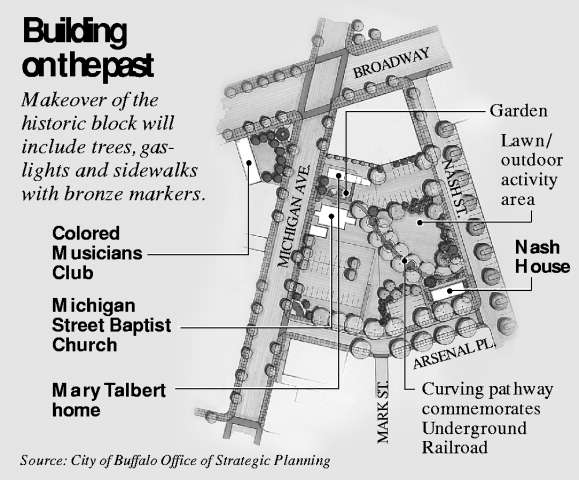| Report in the Buffalo News
New look for historic area $1 million revamp of civil rights sites aims at tourists By TOM BUCKHAM News Staff Reporter 7/12/2005 The neighborhood just south of Michigan Avenue and Broadway, where seeds of the American civil rights movement were sown, is about to be converted into a tourist destination. Under a more than $1 million program unveiled Monday by city officials, the block containing the historic brick Michigan Street Baptist Church, the Jesse Nash House and the site of the former Mary Talbert Home will be transformed into a parklike setting. The blueprint shows a curving pathway commemorating the Underground Railroad extending from the church back to the Nash House on Nash Street, gaslights along the curbs, sidewalks containing bronze markers and plenty of new trees.
Mayor Anthony M. Masiello and his strategic planning chief, Timothy E. Wanamaker, said state funds and federal community development block grant dollars will pay for the project. The improvements will finally illuminate "a significant cultural and spiritual venue," Masiello said. For all of the location's local and national significance, the current streetscape is a bleak one. The historic red brick church sits beside an overgrown vacant lot, amid drab commercial buildings and asphalt parking lots. Except for a blue sidewalk marker, there are no signs welcoming visitors and few trees to shade them. Masiello spoke from a portable podium on the vacant lot where, 100 years earlier to the day, civil rights leader Talbert convened a meeting in her home that led to the Niagara Movement - forerunner of the National Association for the Advancement of Colored People. In the push to establish a network of Western New York heritage tourism destinations, the Michigan Avenue preservation has sometimes been relegated to the back of the bus. The slowness to grasp its historical significance has been matched by a paucity of public and private investment. But that is changing, Wanamaker said. "This is going to be a showcase," he said of the Michigan Heritage Corridor, which also will embrace the Colored Musicians Club and the site of the former Little Harlem nightclub. The city also plans to shape up Broderick Park at the foot of West Ferry Street, an important gateway to freedom in Canada for former slaves fleeing the South. "It shows we really are investing in culture and tourism," Wanamaker said. The plan will help "fulfill the promise of equality for every citizen of Buffalo and Western New York," said Lillian S. Williams of the University at Buffalo School of African American Studies. "I guarantee you, this is going to attract thousands and thousands of
visitors and scholars," added former Common Council President George K.
Arthur, who is overseeing the Nash House restoration. "This neighborhood
is going to return to its heyday."
This material is copyrighted and is for your exclusive personal use only. Republication or other use of this material without the express written consent of The Buffalo News is prohibited. Copyright © 2005 The Buffalo News™ |
 Work will
start in August. Officials hope much of it can be finished in time for
October's 90th convention of the Association for the Study of African American
Life and History, which will bring 800 delegates to town.
Work will
start in August. Officials hope much of it can be finished in time for
October's 90th convention of the Association for the Study of African American
Life and History, which will bring 800 delegates to town.